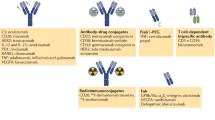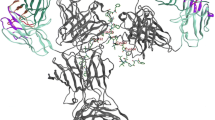Abstract
Rapid innovation of antibody-based modalities to treat different diseases, such as oncology, immuno-oncology, and chronic inflammation, and the speed with which these modalities are progressing through discovery is requiring the acceleration of product development to clinical studies and launch. Development of a stable formulation is critical for initiating and progressing through clinical trials. In this chapter, we provide guidance on leveraging phase-appropriate platform approaches to shorten development cycle time and strategies to arrive at optimal conditions for the final drug product composition and primary container configuration that can maintain the efficacy and safety of the drug as it is processed through various unit operations of manufacturing and administration to the patients.
Access this chapter
Tax calculation will be finalised at checkout
Purchases are for personal use only
Similar content being viewed by others
References
Cleland JL, Powell MF, Shire SJ. The development of stable protein formulations: a close look at protein aggregation, deamidation, and oxidation. Crit Rev Ther Drug Carrier Syst. 1993;10(4):307–77.
Kamerzell TJ, Esfandiary R, Joshi SB, Middaugh CR, Volkin DB. Protein-excipient interactions: mechanisms and biophysical characterization applied to protein formulation development. Adv Drug Deliv Rev. 2011;63(13):1118–59.
Lai MC, Topp EM. Solid-state chemical stability of proteins and peptides. J Pharm Sci. 1999;88(5):489–500.
Ohtake S, Kita Y, Arakawa T. Interactions of formulation excipients with proteins in solution and in the dried state. Adv Drug Deliv Rev. 2011;63(13):1053–73.
Siedler M, Kumar V, Chari R, Saluja S, Fraunhofer W. Development of drug product formulations: molecular design and early candidates screening. In: Jameel F, Hershenson S, Khan MA, Martin-Moe S, editors. Quality by design for biopharmaceutical drug product development. New York: Springer New York; 2015. p. 61–85.
Perez-Ramírez B, Guziewicz N, Simler R, Sreedhara A. Approaches for early developability assessment of proteins to guide quality by design of liquid formulations. In: Jameel F, Hershenson S, Khan MA, Martin-Moe S, editors. Quality by design for biopharmaceutical drug product development. New York: Springer New York; 2015. p. 87–114.
Jarasch A, Koll H, Regula JT, Bader M, Papadimitriou A, Kettenberger H. Developability assessment during the selection of novel therapeutic antibodies. J Pharm Sci. 2015;104(6):1885–98.
Morar-Mitrica S, Adams ML, Crotts G, Wurth C, Ihnat PM, Tabish T, Antochshuk V, DiLuzio W, Dix DB, Fernandez JE, Gupta K, Fleming MS, He B, Kranz JK, Liu D, Narasimhan C, Routhier E, Taylor KD, Truong N, Stokes ESE. An intercompany perspective on biopharmaceutical drug product robustness studies. J Pharm Sci. 2018;107(2):529–42.
Correia IR. Stability of IgG isotypes in serum. MAbs. 2010;2(3):221–32.
Niedziela-Majka A, Kan E, Weissburg P, Mehra U, Sellers S, Sakowicz R. High-throughput screening of formulations to optimize the thermal stability of a therapeutic monoclonal antibody. J Biomol Screen. 2015;20(4):552–9.
Bam NB, Cleland JL, Yang J, Manning MC, Carpenter JF, Kelley RF, Randolph TW. Tween protects recombinant human growth hormone against agitation-induced damage via hydrophobic interactions. J Pharm Sci. 1998;87(12):1554–9.
Beckley NS, Lazzareschi KP, Chih HW, Sharma VK, Flores HL. Investigation into temperature-induced aggregation of an antibody drug conjugate. Bioconjug Chem. 2013;24(10):1674–83.
Pan LY, Salas-Solano O, Valliere-Douglass JF. Conformation and dynamics of interchain cysteine-linked antibody-drug conjugates as revealed by hydrogen/deuterium exchange mass spectrometry. Anal Chem. 2014;86(5):2657–64.
Hedberg SH, Heng JY, Williams DR, Liddell JM. Micro scale self-interaction chromatography of proteins: a mAb case-study. J Chromatogr A. 2016;1434:57–63.
Liu Y, Caffry I, Wu J, Geng SB, Jain T, Sun T, Reid F, Cao Y, Estep P, Yu Y, Vasquez M, Tessier PM, Xu Y. High-throughput screening for developability during early-stage antibody discovery using self-interaction nanoparticle spectroscopy. MAbs. 2014;6(2):483–92.
Sun T, Reid F, Liu Y, Cao Y, Estep P, Nauman C, Xu Y. High throughput detection of antibody self-interaction by bio-layer interferometry. MAbs. 2013;5(6):838–41.
Jacobs SA, Wu SJ, Feng Y, Bethea D, O’Neil KT. Cross-interaction chromatography: a rapid method to identify highly soluble monoclonal antibody candidates. Pharm Res. 2010;27(1):65–71.
Kohli N, Jain N, Geddie ML, Razlog M, Xu L, Lugovskoy AA. A novel screening method to assess developability of antibody-like molecules. MAbs. 2015;7(4):752–8.
Mahler HC, Friess W, Grauschopf U, Kiese S. Protein aggregation: pathways, induction factors and analysis. J Pharm Sci. 2009;98(9):2909–34.
Boswell CA, Tesar DB, Mukhyala K, Theil FP, Fielder PJ, Khawli LA. Effects of charge on antibody tissue distribution and pharmacokinetics. Bioconjug Chem. 2010;21(12):2153–63.
Reusch D, Haberger M, Falck D, Peter B, Maier B, Gassner J, Hook M, Wagner K, Bonnington L, Bulau P, Wuhrer M. Comparison of methods for the analysis of therapeutic immunoglobulin G Fc-glycosylation profiles-Part 2: mass spectrometric methods. MAbs. 2015;7(4):732–42.
Song T, Ozcan S, Becker A, Lebrilla CB. In-depth method for the characterization of glycosylation in manufactured recombinant monoclonal antibody drugs. Anal Chem. 2014;86(12):5661–6.
Chen B, Bautista R, Yu K, Zapata GA, Mulkerrin MG, Chamow SM. Influence of histidine on the stability and physical properties of a fully human antibody in aqueous and solid forms. Pharm Res. 2003;20(12):1952–60.
Paborji M, Pochopin NL, Coppola WP, Bogardus JB. Chemical and physical stability of chimeric L6, a mouse-human monoclonal antibody. Pharm Res. 1994;11(5):764–71.
Yadav S, Liu J, Shire SJ, Kalonia DS. Specific interactions in high concentration antibody solutions resulting in high viscosity. J Pharm Sci. 2010;99(3):1152–68.
Zheng K, Bantog C, Bayer R. The impact of glycosylation on monoclonal antibody conformation and stability. MAbs. 2011;3(6):568–76.
Miller AK, Hambly DM, Kerwin BA, Treuheit MJ, Gadgil HS. Characterization of site-specific glycation during process development of a human therapeutic monoclonal antibody. J Pharm Sci. 2011;100(7):2543–50.
Hoogenboom HR. Selecting and screening recombinant antibody libraries. Nat Biotechnol. 2005;23:1105.
CMC Working Group. A-mAb: A case study in bioprocess development, V 2.1. 2009.
Sreedhara A, Wong RL, Lentz Y, Schoenhammer K, Stark C. Application of QbD principles to late-stage formulation development for biological liquid products. In: Jameel F, Hershenson S, Khan MA, Martin-Moe S, editors. Quality by design for biopharmaceutical drug product development. New York: Springer New York; 2015. p. 115–35.
Timasheff SN. Protein-solvent preferential interactions, protein hydration, and the modulation of biochemical reactions by solvent components. Proc Natl Acad Sci. 2002;99(15):9721–6.
Thirumangalathu R, Krishnan S, Ricci MS, Brems DN, Randolph TW, Carpenter JF. Silicone oil- and agitation-induced aggregation of a monoclonal antibody in aqueous solution. J Pharm Sci. 2009;98(9):3167–81.
Gervais A, Angiuoni G, O’Hara J, Juul Jensen K, Sewerin K, Rossi M, Nedved M, Dillon P, Uddin S, Cornen S, Schnaible V. Forced degradation studies for therapeutic proteins: European Biopharmaceutical Enterprises; 2015. Brussels.
Zheng JY, Janis LJ. Influence of pH, buffer species, and storage temperature on physicochemical stability of a humanized monoclonal antibody LA298. Int J Pharm. 2006;308(1–2):46–51.
Thompson RW Jr, Latypov RF, Wang Y, Lomakin A, Meyer JA, Vunnum S, Benedek GB. Evaluation of effects of pH and ionic strength on colloidal stability of IgG solutions by PEG-induced liquid-liquid phase separation. J Chem Phys. 2016;145(18):185101.
Scherer TM. Cosolute effects on the chemical potential and interactions of an IgG1 monoclonal antibody at high concentrations. J Phys Chem B. 2013;117(8):2254–66.
Inoue N, Takai E, Arakawa T, Shiraki K. Arginine and lysine reduce the high viscosity of serum albumin solutions for pharmaceutical injection. J Biosci Bioeng. 2014;117(5):539–43.
Inoue N, Takai E, Arakawa T, Shiraki K. Specific decrease in solution viscosity of antibodies by arginine for therapeutic formulations. Mol Pharm. 2014;11(6):1889–96.
Wang S, Zhang N, Hu T, Dai W, Feng X, Zhang X, Qian F. Viscosity-lowering effect of amino acids and salts on highly concentrated solutions of two IgG1 monoclonal antibodies. Mol Pharm. 2015;12(12):4478–87.
Hermeling S, Crommelin DJ, Schellekens H, Jiskoot W. Structure-immunogenicity relationships of therapeutic proteins. Pharm Res. 2004;21(6):897–903.
Liu D, Ren D, Huang H, Dankberg J, Rosenfeld R, Cocco MJ, Li L, Brems DN, Remmele RL Jr. Structure and stability changes of human IgG1 Fc as a consequence of methionine oxidation. Biochemistry. 2008;47(18):5088–100.
Houde D, Peng Y, Berkowitz SA, Engen JR. Post-translational modifications differentially affect IgG1 conformation and receptor binding. Mol Cell Proteomics. 2010;9(8):1716–28.
Bertolotti-Ciarlet A, Wang W, Lownes R, Pristatsky P, Fang Y, McKelvey T, Li Y, Li Y, Drummond J, Prueksaritanont T, Vlasak J. Impact of methionine oxidation on the binding of human IgG1 to Fc Rn and Fc gamma receptors. Mol Immunol. 2009;46(8–9):1878–82.
Pan H, Chen K, Chu L, Kinderman F, Apostol I, Huang G. Methionine oxidation in human IgG2 Fc decreases binding affinities to protein A and FcRn. Protein Sci. 2009;18(2):424–33.
Zhang A, Hu P, MacGregor P, Xue Y, Fan H, Suchecki P, Olszewski L, Liu A. Understanding the conformational impact of chemical modifications on monoclonal antibodies with diverse sequence variation using hydrogen/deuterium exchange mass spectrometry and structural modeling. Anal Chem. 2014;86(7):3468–75.
Wang W, Vlasak J, Li Y, Pristatsky P, Fang Y, Pittman T, Roman J, Wang Y, Prueksaritanont T, Ionescu R. Impact of methionine oxidation in human IgG1 Fc on serum half-life of monoclonal antibodies. Mol Immunol. 2011;48(6–7):860–6.
Martin-Moe S, Lim FJ, Wong RL, Sreedhara A, Sundaram J, Sane SU. A new roadmap for biopharmaceutical drug product development: integrating development, validation, and quality by design. J Pharm Sci. 2011;100(8):3031–43.
Author information
Authors and Affiliations
Corresponding author
Editor information
Editors and Affiliations
Rights and permissions
Copyright information
© 2020 American Association of Pharmaceutical Scientists
About this chapter
Cite this chapter
Jameel, F., Moussa, E.M., Mills, B.J., Ihnat, P.M. (2020). Chapter 12: Strategies in the Development of Formulations for Antibody-Based Therapeutics. In: Jameel, F., Skoug, J., Nesbitt, R. (eds) Development of Biopharmaceutical Drug-Device Products. AAPS Advances in the Pharmaceutical Sciences Series, vol 35. Springer, Cham. https://doi.org/10.1007/978-3-030-31415-6_12
Download citation
DOI: https://doi.org/10.1007/978-3-030-31415-6_12
Published:
Publisher Name: Springer, Cham
Print ISBN: 978-3-030-31414-9
Online ISBN: 978-3-030-31415-6
eBook Packages: Biomedical and Life SciencesBiomedical and Life Sciences (R0)




